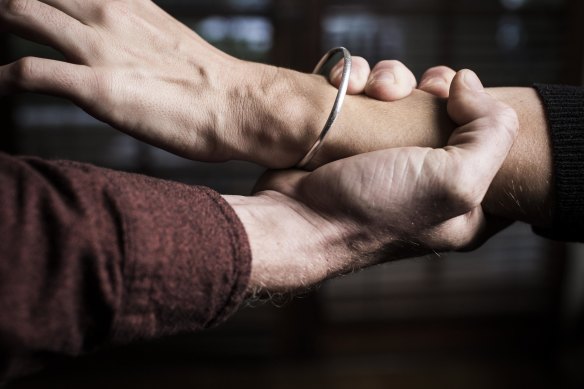By Wendy Tuohy
More than one in five adult Australians, including more than a quarter of men, say they have perpetrated at least one form of sexual violence – and one in 14 people had done so in the past 12 months.
In one of the first studies into self-reported perpetration of sexual violence, the Australian Institute of Criminology found 22 per cent of a representative national sample of 5000 people said they had committed some form of it since the age of 18.

The Australian Institute of Criminology research aims to examine links between pornography and sexual violence.Credit: Dominic Lorrimer
Pressuring someone for dates or sex, emotionally or psychologically manipulating someone to participate in sexual activity, and non-consensual kissing or touching were the most common forms of sexual violence people said they had committed in the past 12 months.
Just over one in 10 respondents (11.4 per cent) said they had perpetrated sexual assault during adulthood, 2.7 per cent said they had had intercourse without the victim’s permission – which is rape – and 2.4 per cent had removed a condom during sex, a practice known as stealthing.
More men (26.4 per cent) than women (17.7 per cent) said they had used a form of sexual violence in adulthood.
“Importantly, while one in six women reported perpetrating some form of sexual violence during adulthood … this was primarily attributable to their rates of sexual harassment and coercion perpetration,” the authors noted.
“These forms of sexual violence were the items with the smallest differences between men and women. In contrast, rates of perpetration of all forms of sexual assault and IBSA [image-based sexual abuse] were two to five times higher for men than women.”
Researcher Dr Christopher Dowling, of the Australian Institute of Criminology, said the levels of self-confessed use of sexual violence exposed in the study were disturbing.
“From harassing and threatening someone for sex, to non-consensual intercourse, this [research] tells us perpetration of sexual violence is disturbingly common,” he said.
“It’s quite shocking to see a number attached to significant acts of sexual violence which reflects how many people in our community freely admit to having done it.”
The study is part of a wider examination by the Australian Institute of Criminology of links between violent pornography and sexual violence.
“Perpetration of multiple forms of sexual violence was significantly more common among men than women,” the report noted.
The Australian Bureau of Statistics released data in late June that showed sexual assault in Australia had reached a 31-year high. It found the number of victim-survivors of sexual assault recorded by police rose by 11 per cent in 2023, the 12th straight annual rise.
The bureau’s head of crime and justice statistics, Samantha McNally, said there were 36,318 victim-survivors of sexual assault recorded by police in 2023, with increases across almost all states and territories.
“Accounting for population growth, the rate of recorded sexual assault victim-survivors has gone up from 126 per 100,000 people last year, to 136 victim-survivors per 100,000 people,” McNally said.
“This is the highest rate of sexual assault victim-survivors recorded in our 31-year dataset.”
The most common age group of victims reported by the bureau was between 10 and 17 years at the date of the incident (41 per cent). This age group was not covered in the criminology institute’s new data, released on Tuesday night, which covered sexual violence perpetrated against adults by adults.
Sexual Assault Services Victoria’s chief executive, Kathleen Maltzahn, and the Full Stop Foundation chief executive Karen Bevan said the fact it only included adult-on-adult perpetration meant true rates were likely far higher.
“There’s a whole lot of people here [admitted perpetrators] who, if they’d had intervention would not have assaulted someone else, but they’re getting away with it so they’re continuing to do it,” Maltzahn said, referring to the finding that perpetration of multiple forms of sexual violence was significantly more common among men than women.
Bevan said the study “tells us people are using sexual violence and they know they are using sexual violence”.
“In Australia, we’ve got a sense that people think violence against women is problem, but it’s other people’s problem: this research shows us it’s everybody’s problem,” she said.
Campaign group Our Watch’s chief executive, Patty Kinnersly, described the data as shocking and said it showed the gendered nature of sexual violence. “The volume of perpetrators demonstrates the need for efforts to end violence against women to be targeting the whole population,” she said.
“The evidence shows that the underlying drivers of violence against women, including sexual violence, are rigid gender stereotypes, gender inequality and disrespect. These attitudes and the violence they drive can be prevented.”
If you or anyone you know needs support, you can contact the National Sexual Assault, Domestic and Family Violence Counselling Service on 1800RESPECT (1800 737 732).
Start the day with a summary of the day’s most important and interesting stories, analysis and insights. Sign up for our Morning Edition newsletter.